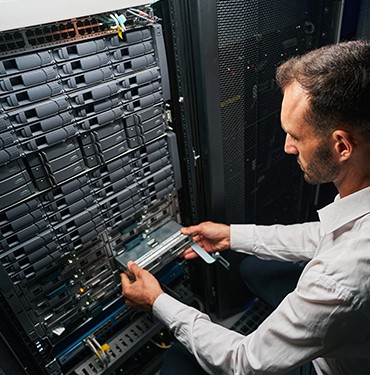Telecommunications equipment
We help our customers create state-of-the-art computer networks: reliable, with adaptive bandwidth, cost-effective. Promotex carries out a full cycle of works, including the selection, supply and installation and maintenance of network equipment from leading manufacturers, as well as the design and deployment of networks:
- Switching,
- Routing,
- SD-WAN


Switching
A switch is a hardware component in network infrastructure that performs the switching process. The switch connects network devices, such as computers and servers, to one another.
A switch enables multiple devices to share a network while preventing each device’s traffic from interfering with other devices’ traffic. The switch acts as a traffic cop at a busy intersection. When a data packet arrives at one of its ports, the switch determines which direction the packet is headed. It then forwards the packet through the correct port for its destination.
Some data packets might come to the switch from devices, like computers or voice-over-IP (VoIP) phones, that are attached directly to it. Other data packets might come to the switch from indirectly connected devices, through a network element such as a hub or router.
The switch knows which of the network’s devices are connected to it, and it can transfer data packets between those devices directly. In other cases, data packets may be going to more-distant destinations, on other networks. A switch in such a scenario forwards the packets to a router, which then forwards them to their destinations on the network.

Routing
A large autonomous network or the internet may present thousands of possible routes between destinations. As networks grow in scale to support mission-critical uses, routing is becoming more important and more complex.
Visibility into network transmission paths for internal and external traffic can help admins identify sources of latency and provide ways to resolve it.
Switches are devices that connect and can help to secure computers, printers, servers, and other devices to networks in homes or organizations.
Routers connect networks to other networks and act as dispatchers. They analyze data to be sent across networks, identify where it needs to go, choose the best routes for it, and send it on its way. Routers connect organizations to the outside world and can help to protect information from outside security threats.
While switches and routers differ in several other ways, a key difference is how they identify end devices. A Layer 2 switch uniquely identifies a device by its MAC address. A Layer 3 router uniquely identifies a device by a network-assigned IP address.

SD-WAN
SD-WAN is a software-defined approach to managing the WAN. The areas needing improvement are generally associated with proprietary backhaul connectivity services, poor network performance, and inconsistent security posture and policy management. All of which inhibit low risk adoption of cloud-based applications and other digital transformation initiatives.
The traditional WAN (wide-area network) function was to connect users at the branch or campus to applications hosted on servers in the data center. Typically, dedicated MPLS circuits were used to help ensure security and reliable connectivity. This has driven Software-defined WAN (SD-WAN) solutions to become increasingly popular as organizations request fast, scalable, and flexible connectivity among different network environments. They also seek to lower the overall total cost of ownership (TCO) while delivering enhanced application performance.
